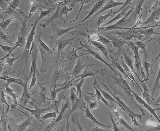Pulmonary Fibroblasts (PF)
Lung Fibroblast Cells

Pulmonary fibroblasts can produce type III collagen, elastin, and protein in the extracellular matrix of alveolar septum. They play an important role in the process of repair and remodeling after tissue injury. The control of the inflammatory site of fibroblasts is critical for effective tissue repair after injury. Inadequate or excessive accumulation of fibroblasts can lead to abnormal tissue function. For example, the excessive proliferation of fibroblasts leads to the development of the outer membrane thickening during hypoxia induced pulmonary hypertension.
Pulmonary fibroblasts are easy to be cultured in vitro, which can be used in gene transfer and micro injection, which can cause vascular remodeling. Pulmonary fibroblasts are the ideal model to study the physiological changes of pulmonary hypertension, pulmonary artery remodeling and pulmonary artery stenosis.
Organism species: Homo sapiens (Human)
- Cell CSI034Hu01 Primary Human Pulmonary Fibroblasts (PF) In Stock
- Customized Service n/a Extract of Pulmonary Fibroblasts (PF) Total Protein/DNA/RNA Extract Customized Service Offer
- Customized Service n/a Medium for Pulmonary Fibroblasts (PF) (If Necessary) Cell Culture Medium Customized Service Offer
Organism species: Mus musculus (Mouse)
- Cell CSI034Mu01 Primary Mouse Pulmonary Fibroblasts (PF) In Stock
- Customized Service n/a Extract of Pulmonary Fibroblasts (PF) Total Protein/DNA/RNA Extract Customized Service Offer
- Medium MSI034Mu11 Medium for Mouse Pulmonary Fibroblasts (PF) In Stock
Organism species: Rattus norvegicus (Rat)
- Cell CSI034Ra01 Primary Rat Pulmonary Fibroblasts (PF) In Stock
- Customized Service n/a Extract of Pulmonary Fibroblasts (PF) Total Protein/DNA/RNA Extract Customized Service Offer
- Medium MSI034Ra11 Medium for Rat Pulmonary Fibroblasts (PF) In Stock
Organism species: Oryctolagus cuniculus (Rabbit)
- Cell CSI034Rb01 Primary Rabbit Pulmonary Fibroblasts (PF) In Stock
- Customized Service n/a Extract of Pulmonary Fibroblasts (PF) Total Protein/DNA/RNA Extract Customized Service Offer
- Medium MSI034Rb11 Medium for Rabbit Pulmonary Fibroblasts (PF) In Stock
Organism species: Felis catus; Feline (Cat)
- Cell CSI034Fe01 Primary Feline Pulmonary Fibroblasts (PF) In Stock
- Customized Service n/a Extract of Pulmonary Fibroblasts (PF) Total Protein/DNA/RNA Extract Customized Service Offer
- Medium MSI034Fe11 Medium for Feline Pulmonary Fibroblasts (PF) In Stock
Organism species: Canis familiaris; Canine (Dog)
- Cell CSI034Ca01 Primary Canine Pulmonary Fibroblasts (PF) In Stock
- Customized Service n/a Extract of Pulmonary Fibroblasts (PF) Total Protein/DNA/RNA Extract Customized Service Offer
- Medium MSI034Ca11 Medium for Canine Pulmonary Fibroblasts (PF) In Stock
Organism species: Sus scrofa; Porcine (Pig)
- Customized Service n/a Pulmonary Fibroblasts (PF) Primary Cells Customized Service Offer
- Customized Service n/a Extract of Pulmonary Fibroblasts (PF) Total Protein/DNA/RNA Extract Customized Service Offer
- Customized Service n/a Medium for Pulmonary Fibroblasts (PF) (If Necessary) Cell Culture Medium Customized Service Offer
Organism species: Bos taurus; Bovine (Cattle)
- Customized Service n/a Pulmonary Fibroblasts (PF) Primary Cells Customized Service Offer
- Customized Service n/a Extract of Pulmonary Fibroblasts (PF) Total Protein/DNA/RNA Extract Customized Service Offer
- Customized Service n/a Medium for Pulmonary Fibroblasts (PF) (If Necessary) Cell Culture Medium Customized Service Offer
Organism species: Capra hircus; Caprine (Goat)
- Cell CSI034Cp01 Primary Caprine Pulmonary Fibroblasts (PF) In Stock
- Customized Service n/a Extract of Pulmonary Fibroblasts (PF) Total Protein/DNA/RNA Extract Customized Service Offer
- Medium MSI034Cp11 Medium for Caprine Pulmonary Fibroblasts (PF) In Stock


